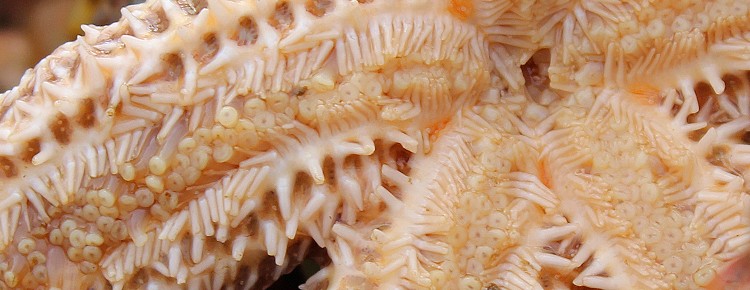
Boring Sponge
The boring sponge is found in waters from the western Atlantic Ocean stretching to the Bahamas. It reproduces asexually and sexually, separating by mitosis or releasing sperm to fertilize a female’s eggs. The sponge makes its home in the shells of oysters, boring into the shell by secreting chemicals that eat away at calcium carbonate. Allowed time, the sponge will bore completely into the flesh of an oyster. At that point, the oyster will die and the sponge will continue to inhabit the shell.
Oyster Drills
An oyster drill is a small predatory snail which can be found in the waters from Nova Scotia, Canada to the state of Florida, Northern Europe and on the west coast of the United States from California to Washington. They have been accidentally introduced to areas outside of their normal habitat. These snails drill a tapered hole into the shells of oysters and consume them. They are a major predator for commercial oyster farms.
Whelk
Whelk prey on oysters the same as oyster drills. These marine gastropods drill into the shell of the oyster and eat them. They inhabit waters in the United Kingdom, France, Norway, Iceland, other European countries, the North Atlantic and some Artic islands. They can be found as far south as New Jersey, USA. Whelk is considered a delicacy in many regions around the world.
Crabs
The diet of a crab includes shellfish such as mussels and oysters. Considered an omnivore, they will also eat snails, worms, fish, fungi, bacteria and anything else they can find. Crabs can be found around the world in a variety of climates. They are a more prevalent predator to oyster grown on the sea floor. The crabs’ average life expectancy is between one and three years.
Lobsters
Much like crabs, lobsters use their claws to efficiently crush an oyster and consume the meat inside. They find their food using small antennae, sensing chemicals in the water. These hard shelled crustaceans are found in waters across the globe, although their physical attributes vary by geographic location.
Worms (Oyster Flatworm/ Oyster Leech)
Shaped like a leaf, oyster flatworms can be cream, grey or orange in colour. Fully grown, they are the size of a quarter. They target primarily oyster spat and eat the meat of the juvenile oyster when it opens its valves to feed. The oyster leech is tan or darker brown in color. They can grow to approximately one inch in length. Oyster leeches will lay their eggs inside the oyster shells they have emptied, providing them protection.
Sea Stars (Starfish)
Sea stars use sensory tubes on their rays (arms) to find their prey. They will penetrate the meat of an oyster and begin inserting their entire stomach inside of the oyster to digest. Digestive chemicals from the sea star’s stomach slowly break down the internal structure of the oyster, leaving behind an empty shell.
Fish
Cownose rays and Oyster toadfish are significant predators to oyster farms. Cownose rays inhabit much of the western Atlantic Ocean, the Caribbean and span further south to Brazil. Brown on top and an off-white or yellow colour on bottom, the cownose ray can grow to a size of 45 inches and weigh 50 pounds or more. They feed on oysters, clams and other invertebrates, crushing their prey with a set of dental plates.
Oyster toadfish are bottom dwellers. They need very little to eat in order to survive. An omnivore, their diet consists of shellfish, squid, crustaceans and small fish. From from Maine to the Caribbean, the Oyster toadfish uses camouflage to remain undetected as they lay waiting for their prey to swim by. They live in shaded areas such as under rocks, in vegetation and wrecks during summer and within oyster reefs at all other times of the year.
Parasitic Disease
Dermo is a term used for a disease in oysters caused by Perkinsus marinus , a single celled parasite. Ingested by the oyster while feeding, it affects the blood cells of the host. The greatest spread of the disease is caused by deceased oysters decomposing and being ingested by. The parasite grows more rapidly in warmer weather. Dermo has the potential to cause a great number of mortalities.
It is believed that the pathogen named ‘MSX’ was introduced on a large scale, via transfers of Pacific oyster. The Pacific oyster is resistant to MSX. The disease limits the feeding rates of infected oysters, effectively starving the animal of carbohydrates.
QX (Queensland Unknown) disease is caused by a single celled parasite called Marteilia sydneyi. It affects the Sydney rock oyster. QX is a seasonal disease, infecting oysters from January to April.
The parasite enters the oyster through the gills and palp and migrates through to the digestive gland. Spores are created by the parasite, destroying the oyster’s digestive gland. Once the oyster has died, the parasite will move on to infect another host. Death due to QX can happen within as little as four weeks from the initial infection. The infected oysters die over the winter months. Infection periods can last between eight and eighteen weeks.
Water Salinity
Oysters grow best when the salt content in the water is within a certain range. The way salt is measured in sea water is by ppt (parts per thousand). Brine water (brine pools) consists of 50+ ppt while saline water (salt lakes, seawater) is between 30 and 50 ppt. Brackish water contains between .5 and 30 ppt (estuaries, brackish seas and lakes) with freshwater only containing 0 to .5 ppt. Oysters thrive in a habitat with between 5 and 35ppt. Short baths in brine water can be used to kill organisms preying on them without adversely affecting the oysters.
Fouling Organisms
Barnacles, starfish, mussel spat and other organisms will hamper the growth of healthy oysters. Management of these organisms is essential in order to maintain a low level of mortality. Common practices to prevent fouling are to turn floating bags or cages regularly, exposing the oysters to the air and washing the grow-out equipment and oysters with a brine solution. It is also important to regularly check equipment and the surrounding environment for fouling organisms in order to mitigate any loss.
We’re here to help. To receive more information on predation, fouling prevention and management for oysters, please give us a call or send us a message using the form to the right.
